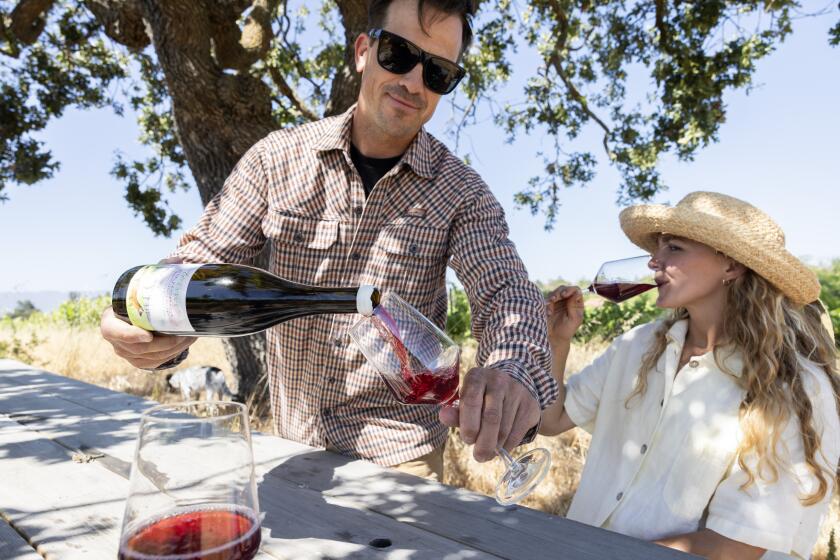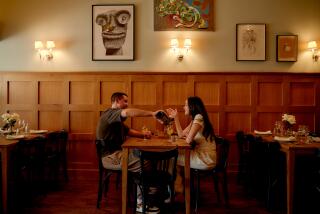
- Share via
- California producers are making sparkling wines that are better than ever.
- For them, it’s not about trying to create something that tastes like Champagne.
- It’s about highlighting the best of California terroir and winemaking innovation.
In 2012, Dan Person joined Schramsberg Winery, the esteemed sparkling-wine house in the Napa Valley, with the desire to learn about bubbles — not just to learn but to be part of the whole bubbles zeitgeist. “Like everyone else,” he says, “when I heard the pop of a cork, I had to turn my head and see what was happening.”
Schramsberg’s reputation had been built on wines meant to approximate Champagne in California. But before long, Person began to wonder what a true California sparkling wine, not a stand-in for Champagne, would taste like. “I wanted to work out whether I could make something not because it tasted like Champagne but because it didn’t,” he says.
A new breed of California sparkling wine from producers who are giving Champagne a run for its money.
In 2017, with his wife, Jacqueline, Person founded Carboniste Winery in Sonoma and embarked upon a minor riot of sparkling wine bottlings, everything from pétillant Albariño to sparkling Merlot to long-aged prestige cuvées made in the traditional methode champenoise — all to see just what sort of sparkling wines California was capable of.

They’ve joined a growing cadre of California producers — wineries like Cruse, Under the Wire, Sandhi, Melville, Blackbird, Patz & Hall, Forlorn Hope and Racines — in the movement to make sparkling wines in California that aren’t wannabes.
For years, domestic sparkling wines would have been lumped into an ice bucket of “lesser-thans.” But no longer. Adjustments in the vineyard and modest tweaks in the cellar have rendered a new style of California bubbles.
At their best they can express a sense of place as well as or better than many of their French counterparts.
The rise of American bubbles
American sparkling wine has been around almost as long as there’s been American wine. The son of one of California’s early wine pioneers, Arpad Haraszthy, studied in Champagne as a youth and debuted a sparkling Zinfandel called Eclipse in the 1870s, which was one of the most popular wines of its era. Post-Prohibition, a small number of reputable producers debuted, including Schramsberg in 1965 and Iron Horse in 1976.
But during the late 1970s and ’80s the category exploded as a host of French companies invested in U.S. satellites, like Mumm, Moët-Chandon, Piper-Heidsieck, Taittinger and Roederer, along with the Spanish Cava producers Cordoniu and Freixenet. Much beyond these, however, the domestic sparkling market didn’t stray.
At Âmevive, working animals, biodiversity, cover crops and no-till farming make for vibrant wines from native yeasts that are part of the DNA of the land.
That is until after the recession of 2008, when wine tourism boomed and direct sales became vital to the bottom line: Offering a glass of bubbles was an essential icebreaker in a memorable tasting-room experience. Custom winemaking facilities like Healdsburg’s Rack and Riddle were able to help meet that demand with a number of sparkling wine options for needy brands.
Others started taking matters into their own hands. Inspired by dramatic new developments in Champagne, where small producers like Jacques Selosse and Ulysse Collin debuted thrilling new sparkling wines made from their own grapes (choosing not to sell to the big houses, or grandes marques).
These not only broke with the style of the grandes marques but also expressed something that few expected from Champagne — a crystalline sense of place, that fabled French concept, terroir.
California terroir
California winemakers took notice. Producers like Michael Cruse, Morgan Twain-Peterson and Chris Cottrell, Sashi Moorman and Rajat Parr started drinking and loving these new Champagnes, eventually creating their own, seeking vineyard sites that met the requirements of sparkling wine — where cool is the rule.
Sparkling wine at first glance is an unlikely vector by which to pursue a sense of place. Most are the product of at least two fermentations as well as the addition of sugar and yeast — a whole host of manipulation and handling, in other words. For centuries Champagne producers set large crops, harvested unripe fruit and bolstered their lackadaisical vineyard efforts by adding copious amounts of sugar (dosage), with uniformity and consistency being the goal. To maintain a global product, the industry, in effect, had ignored terroir at every turn.

Grape growing has improved dramatically in Champagne — the grower-producers have seen to that — but climate change has thrown all manner of obstacles at the region, from excessive heat to rain and even hailstorms.
California is obviously no stranger to global warming’s exigencies, but for now, says winemaker Cruse, “The Pacific Ocean is being a hell of a moderating influence.”
The source of grapes for Cruse’s top wine is a western Sonoma vineyard called Charles Heintz, which experiences such extreme coastal conditions it inspired him to name the wine Ultramarine.
“Charlie is one of those places that’s very strong in its climate expression,” says Cruse. Indeed the wine has so much natural acidity that it can start out quite austere in its youth, needing some years in the bottle to mature and settle before it can be released.
Cruse has since released methode champenoise wines, which are more expressive, under the Cruse Tradition label. It was, he admits, a process to get them there. Drawn from sites less extreme than Charlie, the sense of place sometimes came off as merely fruity, too simple for him.
“Sometimes you have to veer away from that kind of like lemon water, berry spritzer thing, you know?” He found he needed to tamp down their natural exuberance. And so he might adjust the time the wine spends on lees, or expose the wine, in a controlled way, to oxygen. “I think it ends up tasting more California ... more cowboy, more sunshine-y,” he says.
Sunshine in a bottle
Sunshine is something California sparkling wine producers have in abundance, and often must work against; new viticultural techniques have made that prospect easier.
“It’s much easier to grow fruit for sparkling wines than it was,” says Under the Wire’s Twain-Peterson. Shading the fruit with a leaf canopy, adjusting the croploads per vine and being very precise with picking decisions all contribute to a more detailed base wine, the juice that precedes the secondary fermentation — the one that produces bubbles.
That has always been the goal at Under the Wire. Cottrell, Twain-Peterson’s partner, says the brand is devoted to two things: single-vineyard and single-vintage wines that would capture California in sparkling wines. This means they’re unabashed about ripeness. “We’re always looking for intensity of flavor, density of flavor, even at low sugars,” says Cottrell, “and each site usually as a signature for that.”

They’ve found several vineyards, including Alder Springs in Mendocino County, Brosseau Vineyard near Pinnacles National Park in San Benito County and their own Bedrock Vineyard in Sonoma County, that can fully express place when the fruit is less than fully ripe. You could say the sparkling wines are like taut, electrified versions of still wines from these places. But both Cottrell and Twain-Peterson believe that with a little dosage as a kind of corrective lens, it’s how they get their best site differentiation.
Post-Schramsberg, Person’s first out-of-the-box wine was a sparkling Albariño from the San Joaquin Delta — a lowly piece of ground that doesn’t exactly scream terroir. While not exactly profound, the wine is delicious and true to the variety: salty, apple-y and apricot-y — crushable, in the parlance of our time.
His California Brut, V.20, however, has serious methode champenoise gravitas, including a mouthful of nutty lees notes, built off a resolutely Californian core of fruit. “I can capture some elegance and finesse, but I want my wines to have a sunniness and warmth, which is the terroir, after all.”
Uncommon grapes
Mara Ambrose of Forlorn Hope worked at Schramsberg with Person, motivating her to continue making sparkling wine … just not the sort Schramsberg was making. Ambrose experimented with bubbles bottlings made from a half-dozen oddball varieties sourced from her and partner Matthew Rorick’s Sierra Foothills vineyard, Rorick Heritage. She’s settled on two, a Chenin Blanc and a Mondeuse, a grape variety from the mountainous Savoie in France; it struggles to ripen at Rorick, making it ideal for bubbles.
“Making sparkling wine from nontraditional varieties has pushed me to try and capture grape typicity in sparkling form,” Ambrose says. “I can’t tell you how happy it’s made me when other winemakers say, ‘Wow! This really tastes like Mondeuse!’”
Winemakers from the French wineries haven’t been left out of this effort. In the Anderson Valley, Roederer Estate, arguably the most qualitatively successful of all the expatriate houses, has been run for many years by Frenchman Arnaud Weyrich, who couldn’t help but notice the success of Cruse and others.
“I have to say, those small wineries, Ultramarine, they kicked my butt a little,” Weyrich says.
But among Roederer’s vast vineyard holdings (some 340 planted acres in the Anderson Valley) a number of parcels kept rising to the top as standouts; this year, Weyrich bottled two.
The first, on Clark Road, is a Pinot Noir vineyard, among the coolest they own, producing a racy, structured wine. A slightly warmer block, Apple Alley, is ideal for Chardonnay. In France such parcels would be called Grand Cru. Weyrich simply calls them his “top dogs.” Each is dramatically different from the other, and from the winery’s top wine, L’Ermitage.
Racines is another remarkable French venture started by Étienne de Montille, scion of the esteemed Domaine de Montille in Burgundy, and his winemaker Brian Sieve. In 2016 they established a winery in the Sta. Rita Hills (hiring Oregon veteran Ryan Hannaford as their viticulturist and on-site winemaker). In 2018, when it became clear that this windswept region would be amenable to good sparkling wine fruit, De Montille called in his friend Rodolphe Péters, who represents the sixth generation of the Péters family in Champagne’s Côte de Blancs.
The Racines Grande Reserve performs the feat of tasting like a California wine and like a Péters wine but not, necessarily, a Champagne wine. Its generous, golden rich middle palate and precise finish is the very signature I associate with Péters, though its California-ness — expressed as it is through the Sta. Rita Hills fog — I’d never take for Champagne. That is precisely the sort of synergy the best domestic sparkling wines are pulling off right now.
More to Read
Eat your way across L.A.
Get our weekly Tasting Notes newsletter for reviews, news and more.
You may occasionally receive promotional content from the Los Angeles Times.












